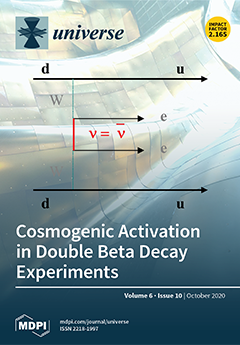Open AccessArticle
Search for Double Beta Decay of 106Cd with an Enriched 106CdWO4 Crystal Scintillator in Coincidence with CdWO4 Scintillation Counters
by
Pierluigi Belli, R. Bernabei, V.B. Brudanin, F. Cappella, V. Caracciolo, R. Cerulli, F. A. Danevich, Antonella Incicchitti, D.V. Kasperovych, V.R. Klavdiienko, V.V. Kobychev, Vittorio Merlo, O.G. Polischuk, V.I. Tretyak and M.M. Zarytskyy
Cited by 14 | Viewed by 1962
Abstract
Studies on double beta decay processes in
Cd were performed by using a cadmium tungstate scintillator enriched in
Cd at 66% (
CdWO
) with two CdWO
scintillation counters (with natural Cd composition). No effect was observed in
[...] Read more.
Studies on double beta decay processes in
Cd were performed by using a cadmium tungstate scintillator enriched in
Cd at 66% (
CdWO
) with two CdWO
scintillation counters (with natural Cd composition). No effect was observed in the data that accumulated over 26,033 h. New improved half-life limits were set on the different channels and modes of the
Cd double beta decay at level of
yr. The limit for the two neutrino electron capture with positron emission in
Cd to the ground state of
Pd,
yr, was set by the analysis of the
CdWO
data in coincidence with the energy release 511 keV in both CdWO
counters. The sensitivity approaches the theoretical predictions for the decay half-life that are in the range
yr. The resonant neutrinoless double-electron capture to the 2718 keV excited state of
Pd is restricted at the level of
yr.
Full article
►▼
Show Figures





